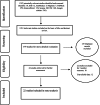Evaluation of skin lesions in diabetic patients: a systematic review and meta-analysis
- PMID: 33520868
- PMCID: PMC7843671
- DOI: 10.1007/s40200-020-00629-7
Evaluation of skin lesions in diabetic patients: a systematic review and meta-analysis
Abstract
Backgroud: Prevalence of skin lesions among diabetic patients is a major health concern. Therefore, this systematic review and meta-analysis study was conducted to determine the prevalence of skin lesions in diabetic patients.
Methods: To identify and select relevant articles, the SID, MagIran, IranMedex, IranDoc, Google Scholar, Cochrane, Embase, ScienceDirect, Scopus, PubMed, and Web of Science (WoS) databases were searched without a lower time limit and until April 2020. The random effects model was used to perform the analysis, and the heterogeneity of studies was assessed using the I2 index. Data were analyzed within the Comprehensive Meta-Analysis (Version 2) software.
Results: After evaluating the 22 final articles with a total sample size of 8406, the prevalence of skin lesions among diabetes patients were found as 70.3% (95% CI: 63-76.7%). Moreover, according to the meta-regression analysis, the effect of 'sample size' on th prevalence of skin lesions was significantly different in diabetes patients (p < 0.05).
Conclusion: The results of this study show that skin lesions are common in diabetes patients. Therefore, appropriate policies needs to be adopted to improve the situation and to monitor patients and outcomes at all levels.
Keywords: Diabetes; Meta-analysis; Prevalence; Skin lesions.
© Springer Nature Switzerland AG 2020.
Conflict of interest statement
Conflict of interestThe authors declare that they have no conflict of interest.
Figures





References
-
- Ferinkel R, Freinkel N. Cutaneous manifestations of endocrine diseases. u: Fitzpatrick TB i dr.[ur.]. Dermatology in general medicine, New York, itd: McGraw-Hill. 1993:2113–31.
Publication types
LinkOut - more resources
Full Text Sources
Miscellaneous

